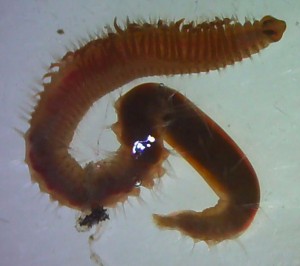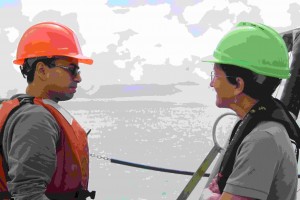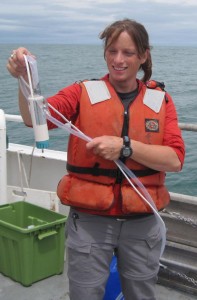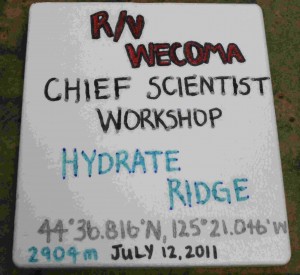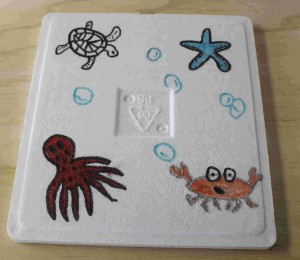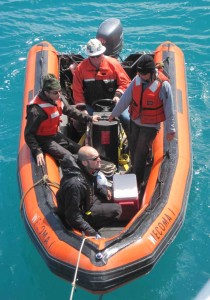 The W1106A chief scientist workshop group. From left to right back row: Daryl Swenson, Amy Townsend-Small, Meghan Donohue, Clare Reimers, Aaron Beck, Russell Carvalho, Alyson Santoro, Chris Hintz, Dan Thornton. Middle row: Yuehan Lu, Lindsey Koren, Sarah Brooks, Kim Null, Shellie Bench, Chandranath Basak. Front row: Pat Wheeler, Joaquin Martinez Martinez, Penny Vlahos.
The W1106A chief scientist workshop group. From left to right back row: Daryl Swenson, Amy Townsend-Small, Meghan Donohue, Clare Reimers, Aaron Beck, Russell Carvalho, Alyson Santoro, Chris Hintz, Dan Thornton. Middle row: Yuehan Lu, Lindsey Koren, Sarah Brooks, Kim Null, Shellie Bench, Chandranath Basak. Front row: Pat Wheeler, Joaquin Martinez Martinez, Penny Vlahos.
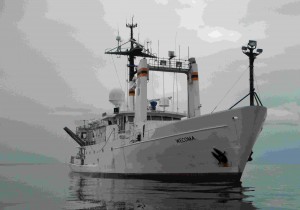 R/V Wecoma on a glassy Oregon shelf sea. The CTD is being deployed off the A-frame extending away from the ship.
R/V Wecoma on a glassy Oregon shelf sea. The CTD is being deployed off the A-frame extending away from the ship.
(Photo: J. Martinez Martinez)
 The CTD rosette brought on board full of samples. Penny Vlahos (L) and marine tech Meghan (R) guide the rosette home and protect it from crashing into surrounding walls as the ship rolls with the swell.
The CTD rosette brought on board full of samples. Penny Vlahos (L) and marine tech Meghan (R) guide the rosette home and protect it from crashing into surrounding walls as the ship rolls with the swell.
(Photo: J. Martinez Martinez)
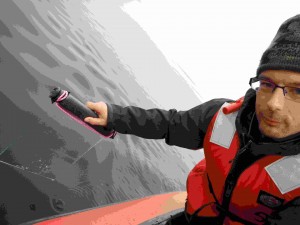
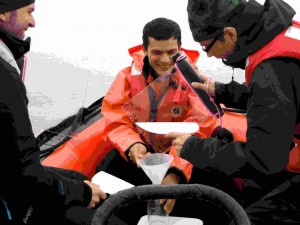
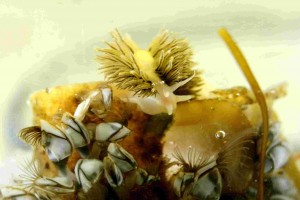
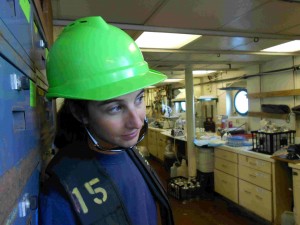
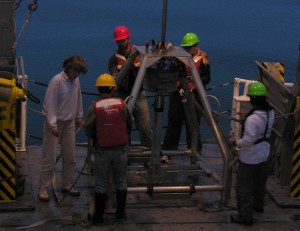
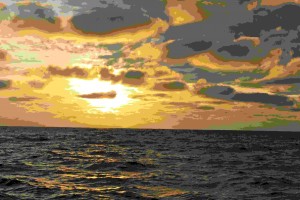 Dan Thornton demonstrates proper glass-plate-dipping method for collecting sea surface microlayer samples. Excess water drains off the plate, and the microlayer skin is carefully wiped into a collection vessel (see picture below).
Dan Thornton demonstrates proper glass-plate-dipping method for collecting sea surface microlayer samples. Excess water drains off the plate, and the microlayer skin is carefully wiped into a collection vessel (see picture below).
(Photo: J. Martinez Martinez)
Dan collects the microlayer sample from his glass plate as Aaron Beck (L) and Joaquin Martinez Martinez (C) look on. Each 400 mL sample requires 200 or more plate dips.
(Photo: Jeff C.)
A piece of floating kelp collected from the zodiac is teeming with life. A nudibranch crawls across the top in this picture and barnacles extend filtering apparatus from their shells.
(Photo: C. Hintz)
Marine tech Meghan keeps an eye on CTD ops from the Wecoma wet lab.
(Photo: C. Reimers)
Clare Reimers (L) provides expert sediment core troubleshooting after the coring rig is secured on deck. Hard-hatted corers are (clockwise from red): marine tech Daryl, Amy Townsend-Small, Russell Carvalho, and Chandranath Basak.
(Photo: S. Bench)
The requisite Sunset Over Sea picture. Clear weather and calm seas are the order of the day. Good luck, September workshop cohort…
(Photo: L. Koren)
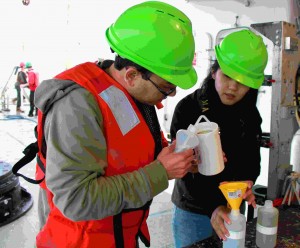 Still life of co-chief with ship. Joaquin Martinez Martinez with R/V Wecoma in the background.
Still life of co-chief with ship. Joaquin Martinez Martinez with R/V Wecoma in the background.
(Photo: A. Beck)
Chandranath Basak rinses his phytoplankton tow net sample while Yuehan Lu supervises. Never underestimate the value of moral support or lime-green hard hats.
(Photo: L. Koren)
![]() (Above) The Oregon coast, as seen from the deck of R/V Wecoma. Cruise weather isn’t always so beautiful, but we’ll take it while it lasts!
(Above) The Oregon coast, as seen from the deck of R/V Wecoma. Cruise weather isn’t always so beautiful, but we’ll take it while it lasts!
(Photographed and stitched by C. Hintz)
A Spionid polychaete from 1800 meters below the sea (greatly magnified).
(Photo: R. Carvalho)
Clare Reimers, mentoring from the doghouse, winch control central.
(Photo: S. Brooks)
Sarah Brooks and Dan Thornton, hard at work. Despite what our blog suggests, it’s not all good food and styrofoam fun here.
Chandranath Basak and Pat Wheeler discuss plankton on the fantail after a successful net tow.
(Photo: L. Koren)
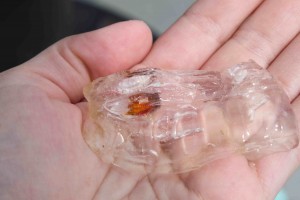 A large salp, a gelatinous zooplankter, captured in the net tow. The orange portion is its digestive system, and the clear structure is used to filter its planktonic food from the water column.
A large salp, a gelatinous zooplankter, captured in the net tow. The orange portion is its digestive system, and the clear structure is used to filter its planktonic food from the water column.
(Photo: L. Koren)
Kim Null proudly displays a large salp accidentally caught on her surface water pump.
(Photo: S. Brooks)
Top view of a styrofoam lid, before taking a trip to the seafloor.
Top view of the lid. Despite the fact that none of the cruise participants study these animals, even marine chemists and microbiologists are compelled to draw sea turtles and starfish. (Note the accurate appendage count on the octopus though.)
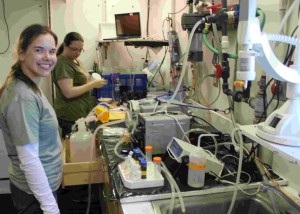 Lindsey Koren and Shellie Bench tend a complicated array of scientific equipment. Lindsey measures gases such as CO2 and oxygen and takes samples for carbon analysis, and Shellie operates a multi-sensor water probe and collects samples for genetic analysis.
Lindsey Koren and Shellie Bench tend a complicated array of scientific equipment. Lindsey measures gases such as CO2 and oxygen and takes samples for carbon analysis, and Shellie operates a multi-sensor water probe and collects samples for genetic analysis.
Returning from RHIB (Rigid-Hull Inflatable Boat) ops to collect sea-surface microlayer and trace metal samples. Clockwise from left: Dan Thornton, seaman Patrick, Penny Vlahos, and Aaron Beck.
(Photo: S. Brooks)


